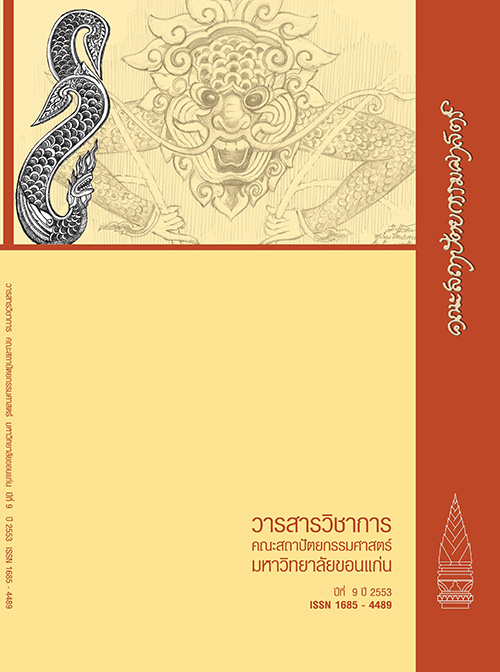การประยุกต์มิติทางวัฒนธรรมเพื่อการพัฒนาการออกแบบผลิตภัณฑ์ ผ้าย้อมครามบ้านคันพะลาน ตำบลนาตาล อำเภอนาตาล จังหวัดอุบลราชธานี
คำสำคัญ:
คันพะลาน, คราม, ออกแบบและพัฒนาผลิตภัณฑ์, Kanpalan, Indigo, Product Design and Developmentบทคัดย่อ
โครงการการประยุกต์มิติทางวัฒนธรรมเพื่อการพัฒนาการออกแบบผลิตภัณฑ์ผ้าฝ้ายย้อมคราม บ้านคันพะลาน ตำบล นาตาล อำเภอนาตาล จังหวัดอุบลราชธานี เป็นการวิจัยเพื่อท้องถิ่น Community -based research ซึ่งมีลักษณะการวิจัยที่เน้น การวิจัยอย่างมีส่วนร่วม งานวิจัยได้รับทุนสนับสนุนจากสำนักงานกองทุนสนับสนุนการวิจัย (สกว.) ปี 2551 การวิจัยได้เริ่มใน เดือนกรกฎาคม พ.ศ. 2551 และดำเนินการเสร็จสิ้นเดือน ธันวาคม 2552 ในการดำเนินการวิจัยมีวัตถุประสงค์เพื่อ (1) ศึกษา ข้อมูลด้านวิถีชีวิต วัฒนธรรม ความเป็นมาของชุมชนทอผ้าพื้นเมืองและลวดลายผ้าจากอดีตจนถึงปัจจุบัน (2) ศึกษาความ พร้อมและความสามารถในการผลิตผ้าทอพื้นเมืองของชุมชนเพื่อหาแนวทางในการส่งเสริมพัฒนาการออกแบบผ้าทอพื้นเมือง (3) หารูปแบบกระบวนการในการถ่ายทอดพัฒนาการออกแบบลายผ้าที่เชื่อมโยงกับมิติทางวัฒนธรรมของชุมชน (4) พัฒนาด้าน การตลาดในด้านราคาและการบริหารจัดการด้านการตลาดเพื่อเพิ่มโอกาสในการจำหน่ายผ้าฝ้ายย้อมคราม บ้านคันพะลานเป็นชุมชนที่ปลูกไร่ฝ้ายและไร่ครามริมแม่นํ้าโขง เพื่อใช้ในการผลิตผ้าฝ้ายย้อมคราม แต่เนื่องจาก
บ้านคันพะลานอยู่ห่างไกลตัวจังหวัด จึงทำให้ชุมชนทอผ้าประสบปัญหาในการพัฒนาอาชีพการทอผ้า ดังนั้นในการทำวิจัย จึงเริ่มจากการดำเนินการศึกษาวิถีชีวิตและมิติทางวัฒนธรรมท้องถิ่น ซึ่งมีความสัมพันธ์กับการทอผ้าของชุมชนทอผ้าบ้าน คันพะลานและรายได้จากการทอผ้าใช้จุนเจือครอบครัว การดำเนินการวิจัยมีการจัดเวทีพูดคุยถึงปัญหาต่างๆ ในการผลิต ผ้าทอมือร่วมกับนักวิจัยอาสาสมัครบ้านคันพะลาน ทำให้ทีมวิจัยได้ทราบปัญหาของชุมชนใน 2 ประเด็นได้แก่ (1) การขาด ความภาคภูมิใจในฝีมือและเอกลักษณ์ในการทอผ้า (2) การขาดรูปแบบในการบริหารจัดการด้านคุณภาพการผลิตและ การจัดจำหน่าย ด้วยเหตุนี้ทีมวิจัยจึงได้หาแนวทางการแก้ปัญหาร่วมกัน โดยมีสมาชิกกลุ่มทอผ้าเข้าร่วมเป็นนักวิจัยชุมชน กระบวนการวิจัยเริ่มจากการศึกษาความประวัติความเป็นมาของการทอผ้า การรวบรวมลวดลายการมัดผ้าหมี่ จากลายผ้า ที่ยังคงหลงเหลืออยู่ในชุมชนและร่วมกันคัดลอกลายผ้า หลังจากนั้นได้มีการพูดคุยกันถึงกระบวนออกแบบ การสร้างแรง บันดาลใจในการออกแบบของช่างทอผ้า เพื่อสร้างความเข้าใจในพื้นฐานการออกแบบให้นักวิจัย ในการออกแบบลายผ้า ชุมชนรวมได้คิดค้นลวดลายผ้าขึ้นมาใหม่ในนามลาย “ สามพันโบก” โดยได้แรงบันดาลใจจากสถานที่ท่องเที่ยวทางธรรมชาติ ในแม่นํ้าโขงที่อยู่ใกล้หมู่บ้าน มีการจัดการศึกษาดูงานการจัดการบริหารกลุ่มกับกลุ่มทอผ้า สีธรรมชาติบ้านโคกภูเก่า จังหวัดสกลนครเพื่อศึกษารูปแบบในการบริหารจัดการกลุ่ม การดูงานทำให้เกิดการแลกเปลี่ยนความรู้และแนวความคิดกันอย่าง หลากหลาย และส่งผลให้นักวิจัยบ้านคันพะลานร่วมกันจัดตั้งกลุ่มทอผ้าของหมู่บ้านที่มีรูปแบบการผลิตและการบริหารจัดการที่ เข้มแข็ง มีกระบวนการผลิตผ้าทอที่มีคุณภาพและสามารถจำหน่ายได้ในราคาที่ยุติธรรม อีกทั้งยังได้รับทุนสนับสนุนจากองค์การ บริหารส่วนตำบลนาตาลซึ่งเป็นหน่วยงานของภาครัฐ นอกจากนี้กลุ่มทอผ้ายังได้ร่วมกันคิดชื่อทางการค้าภายใต้ชื่อ “ดอกฝ้ายริม โขง” เป็นชื่อที่เป็นเอกลักษณ์เพื่อใช้ในการค้าและการพัฒนาสินค้าของกลุ่มต่อไปในอนาคต
The Integration of Cultural Dimensions into the Development of Indigo-dyed Cotton Products by Villagers of Kanpalan Village
This research sought to investigate the integration of cultural dimensions into the development of indigo-dyed cotton products by villagers of Kanpalan Village, Natan Subdistrict, Natan District, Ubon Ratchathani Province. It was a community-based participatory research project funded by the Thailand Research Fund (TRF) in 2008. The project started in July 2008 and was completed in December 2009.
The objectives of the research were as follows: (1) to compile facts regarding the way of life, culture, and history of this traditional cloth-weaving community and their weaving patterns throughout the community’s history, (2) to explore readiness and ability of the community in order to develop appropriate approaches to support the development of product patterns, (3) to explore methods of developing weaving designs which reflect local cultural values, and (4) to develop marketing strategies especially in pricing and market management to create opportunities to increase the sales of cotton indigo-dyed woven products.
Kanpalan Village has cotton and indigo plantations along the Kekong river bank. The plantations yield crops for good quality cotton and indigo products. However, because the village is far from the provincial urban center, the villagers were faced with the lack of access to professional development. This research project, therefore, began by exploring whether the villagers’ way of life and their local cultural values were related to the status of their weaving profession and the household income which it generated.
During the research program, discussions between the researchers and volunteer researchers from the village have uncovered two major problems faced by this weaving community: (1) the villagers’ lack of pride in their craftsmanship skills and the uniqueness of their weaving patterns, and (2) the lack of quality management and marketing strategies. With the collaboration by the village’s volunteer researchers, solutions to the problems were proposed. In the first stage of this research, historical facts regarding the weaving methods and indigo-dyeing patterns called Mad Mee were collected from available heirloom fabric. Next, the researchers shared discussions of designing procedures and weavers’ inspirations in designing in order to lead to a better understanding of designing principles. As a result, the community has created a new design called “Sam Pan Bok” (meaning three thousand holes) inspired by the local natural attraction by the Mekong after which the design was named.
The project also organized a fieldtrip for the villagers to visit Kok Phu Kao Village in Sakon Nakhorn Province as an opportunity to share their professional experience and knowledge and learn about the management model employed in Kok Phu Kao Village. The villagers subsequently established a formal group which was run to with an effective product quality control and management system. The group produced high quality fabric which was sold at reasonable prices. They also gained support by Natan Subdistrict Administration Organization (SAO) which is a government agency. The group successfully created their own commercial brand called “Dok Fai Rim Khong” (Mekong cotton blossoms), the brand under which the group aimed to produce fabric products representing its cultural identity in the future.
ดาวน์โหลด
รูปแบบการอ้างอิง
ฉบับ
ประเภทบทความ
สัญญาอนุญาต
ทัศนะและข้อคิดเห็นของบทความที่ปรากฏในวารสารฉบับนี้เป็นของผู้เขียนแต่ละท่าน ไม่ถือว่าเป็นทัศนะและความรับผิดชอบของกองบรรณาธิการ




